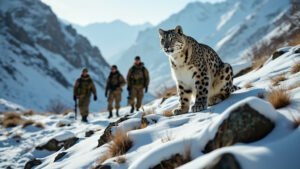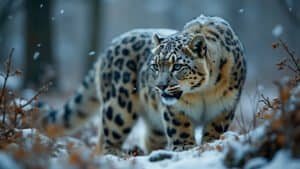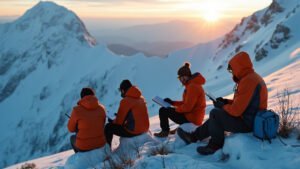Introduction
International organizations play a pivotal role in the conservation of the endangered snow leopard, a majestic and elusive big cat native to the mountain ranges of Central and South Asia
This article will explore the significant contributions of key organizations such as WWF, the Snow Leopard Trust, and the UNDP, highlighting their initiatives, successes, and future plans
We will also delve into the challenges faced in conservation efforts and the collaborative strategies employed to ensure the survival of this iconic species. Through an in-depth analysis, we aim to shed light on the vital role these organizations play in protecting the snow leopard and its habitat
Key International Organizations in Snow Leopard Conservation
International organizations have been instrumental in the efforts to conserve snow leopards, providing critical support and resources to protect these endangered animals
This section will delve into the major players involved in snow leopard conservation, their specific roles, and how they collaborate to enhance conservation efforts
Major Players in Snow Leopard Conservation
Several international organizations are at the forefront of snow leopard conservation efforts. Among the most notable are the World Wildlife Fund (WWF), the Snow Leopard Trust, and the United Nations Development Programme (UNDP)
These organizations not only bring significant funding and expertise but also facilitate cross-border collaborations crucial for the snow leopard’s survival, given their vast and often transnational habitat:
World Wildlife Fund (WWF): The WWF is one of the most recognized names in wildlife conservation globally. Their involvement in snow leopard conservation includes habitat preservation, anti-poaching efforts, and community engagement programs to mitigate human-wildlife conflict
Snow Leopard Trust: Focused solely on the conservation of snow leopards, the Snow Leopard Trust conducts extensive research, implements community-based conservation programs, and works directly with local populations to promote coexistence
United Nations Development Programme (UNDP): The UNDP’s role in snow leopard conservation is part of its broader mandate to address environmental sustainability. Through initiatives like the Global Environment Facility (GEF), the UNDP supports various projects aimed at protecting snow leopards and their habitats
Specific Roles of Each Organization
WWF’s Role
Habitat Preservation: WWF works to protect and restore critical habitats, ensuring that snow leopards have the space they need to thrive. This includes establishing protected areas and corridors that facilitate genetic flow between populations
Anti-Poaching Efforts: The WWF collaborates with local authorities to combat poaching, which is a significant threat to snow leopards. They provide training and resources to enhance anti-poaching patrols and law enforcement
Community Engagement: Recognizing that human-wildlife conflict is a major issue, the WWF engages local communities in conservation efforts. Programs are designed to reduce livestock predation and promote sustainable livelihoods that do not harm wildlife
Snow Leopard Trust’s Role
Research and Monitoring: The Snow Leopard Trust conducts extensive field research to understand snow leopard behavior, population dynamics, and threats. They use this data to inform and improve conservation strategies
Community-Based Conservation: The Trust works directly with local communities, involving them in conservation activities. This includes livestock insurance programs to compensate for losses to snow leopards and promoting handicrafts made by local artisans, providing alternative income sources
Education and Awareness: Education programs are aimed at increasing awareness about the importance of snow leopards and the need to protect them. These initiatives target both local communities and broader audiences to garner widespread support for conservation
UNDP’s Role
Global Environment Facility (GEF): Through the GEF, the UNDP funds various projects that aim to conserve snow leopards and their habitats. These projects often focus on sustainable land management practices and biodiversity conservation
Policy and Governance: The UNDP works with governments to develop and implement policies that favor conservation. This includes creating legal frameworks that protect snow leopards and their habitats
Capacity Building: The UNDP supports capacity-building initiatives that enhance the ability of local and national authorities to manage and protect snow leopard populations. This includes training in wildlife management and community engagement
Collaborative Efforts Among Organizations
Collaboration is key to the success of snow leopard conservation. Given the extensive range of snow leopards, which spans across multiple countries, international cooperation is essential
These organizations often work together on large-scale projects, share research and data, and coordinate efforts to maximize impact:
Global Snow Leopard & Ecosystem Protection Program (GSLEP): A notable example of collaboration is the GSLEP, which brings together 12 snow leopard range countries along with international organizations like the WWF, Snow Leopard Trust, and UNDP. This program aims to secure the long-term survival of snow leopards through a comprehensive approach that includes habitat protection, anti-poaching efforts, and community engagement
Joint Research and Monitoring: Collaborative research initiatives help in pooling resources and expertise. By sharing data and findings, these organizations can develop more effective conservation strategies and monitor the impact of their efforts more accurately
Funding and Resource Allocation: International organizations often pool funds to support large-scale conservation projects. This collaborative funding model ensures that resources are used efficiently and that critical areas receive the attention they need
By working together, these organizations amplify their impact, ensuring that conservation efforts are more comprehensive, sustainable, and effective. Their combined efforts are crucial in addressing the multifaceted challenges faced in snow leopard conservation, from habitat loss and poaching to human-wildlife conflict and climate change
WWF’s Role in Snow Leopard Conservation
The World Wildlife Fund (WWF) has been a cornerstone in global wildlife conservation, and its efforts in snow leopard conservation are no exception. This section will explore WWF’s key initiatives, successes, and future plans in their mission to protect this elusive big cat
Key WWF Initiatives
WWF’s approach to snow leopard conservation is multi-faceted, focusing on habitat protection, anti-poaching measures, and community engagement. Each initiative is designed to address specific threats and promote sustainable coexistence between humans and snow leopards
Habitat Protection
Protected Areas and Corridors: WWF works to establish and maintain protected areas that are critical to snow leopard survival. They focus on creating wildlife corridors that connect fragmented habitats, ensuring genetic diversity and reducing inbreeding risks
Sustainable Land Management: Partnering with local communities and governments, WWF promotes sustainable land-use practices that balance human needs with wildlife conservation. This includes initiatives to prevent overgrazing and deforestation, which can degrade snow leopard habitats
Anti-Poaching Efforts
Patrols and Surveillance: WWF supports the training and equipping of anti-poaching patrols in snow leopard territories. These patrols use advanced technologies like camera traps and GPS tracking to monitor and protect snow leopards from poachers
Legislation and Enforcement: By working with local and national authorities, WWF advocates for stronger wildlife protection laws and better enforcement mechanisms. They also help to build the capacity of law enforcement agencies to effectively combat wildlife crime
Community Engagement
Conflict Mitigation: Recognizing that human-wildlife conflict is a significant issue, WWF implements programs to mitigate these conflicts. One example is the promotion of predator-proof livestock pens, which help prevent snow leopard attacks on livestock
Sustainable Livelihoods: WWF engages local communities in sustainable livelihood projects that reduce dependence on activities harmful to snow leopard habitats. These projects include eco-tourism, handicrafts, and sustainable agriculture practices
Success Stories and Achievements
WWF’s efforts in snow leopard conservation have led to several notable successes and achievements, demonstrating the effectiveness of their strategies:
Increase in Protected Areas: Thanks to WWF’s advocacy and collaboration with governments, several new protected areas have been established in snow leopard habitats. These protected areas provide safe havens for snow leopards and other wildlife, contributing to the overall stability of their populations
Reduction in Poaching: Enhanced anti-poaching measures supported by WWF have led to a significant reduction in poaching incidents in key snow leopard habitats. The increased presence of patrols and improved law enforcement have deterred poachers and protected snow leopards from illegal hunting
Community-Based Conservation: WWF’s community engagement programs have fostered greater local support for snow leopard conservation. By involving communities in conservation efforts and providing alternative income sources, WWF has helped to reduce human-wildlife conflict and promote sustainable coexistence
Scientific Research and Monitoring: WWF’s support for scientific research has provided valuable insights into snow leopard behavior, population dynamics, and threats. This research has informed conservation strategies and helped to track the effectiveness of various initiatives
Future Plans and Goals
WWF continues to build on its successes with ambitious plans and goals for the future, aiming to secure a better future for snow leopards:
Expansion of Protected Areas: WWF aims to further expand the network of protected areas and wildlife corridors, ensuring that snow leopards have sufficient space to roam and thrive. They also plan to enhance the management and protection of existing protected areas
Strengthening Anti-Poaching Efforts: WWF will continue to bolster anti-poaching efforts by increasing patrols, enhancing surveillance technologies, and advocating for stronger legal protections. They also plan to increase collaboration with international law enforcement agencies to tackle cross-border wildlife crime
Scaling Up Community Engagement: WWF plans to scale up community engagement programs, reaching more communities and expanding the scope of sustainable livelihood projects. By empowering local populations, WWF aims to create a more sustainable and supportive environment for snow leopard conservation
Leveraging Technology: WWF is exploring the use of new technologies, such as drones and artificial intelligence, to improve monitoring and protection efforts. These technologies can provide real-time data on snow leopard movements and threats, enabling more effective conservation strategies
Global Partnerships: WWF will continue to strengthen its partnerships with other international organizations, governments, and local NGOs. By fostering collaboration, WWF aims to create a more cohesive and comprehensive approach to snow leopard conservation
The World Wildlife Fund’s dedicated efforts in snow leopard conservation have made significant strides in protecting this endangered species
Their holistic approach, combining habitat protection, anti-poaching measures, and community engagement, has set a strong foundation for future conservation efforts. Through continued innovation and collaboration, WWF is poised to make even greater contributions to the survival and well-being of snow leopards
Snow Leopard Trust Initiatives
The Snow Leopard Trust is a specialized organization dedicated to the conservation of snow leopards and their habitats. This section will provide an overview of the Trust, its conservation projects, and the measurable impact of its initiatives
Overview of the Snow Leopard Trust
The Snow Leopard Trust was founded in 1981 with the primary goal of protecting snow leopards in their natural habitats. With a focus on scientific research, community involvement, and education, the Trust has become a leading authority on snow leopard conservation
Operating in key snow leopard range countries, including Mongolia, India, Pakistan, Kyrgyzstan, and China, the Trust works closely with local communities and governments to implement effective conservation strategies
Conservation Projects and Programs
The Snow Leopard Trust’s conservation efforts are diverse and multifaceted, addressing various threats to snow leopards and promoting sustainable practices among local populations
Scientific Research and Monitoring
Long-Term Ecological Studies: The Trust conducts extensive field research to monitor snow leopard populations, track their movements, and understand their behavior. This research is crucial for developing effective conservation strategies and policies
Camera Trapping and GPS Collaring: Using advanced technologies like camera traps and GPS collars, the Trust collects data on snow leopard activities and habitats. This information helps in identifying critical areas for protection and assessing the impact of conservation efforts
Community-Based Conservation
Livestock Insurance Program: One of the Trust’s flagship initiatives is the livestock insurance program, which compensates herders for livestock losses due to snow leopard predation. This program reduces retaliatory killings and fosters coexistence between humans and snow leopards
Handicraft and Sustainable Livelihoods: The Trust promotes handicraft production among local communities, providing an alternative income source that reduces reliance on livestock. Products made by local artisans are sold internationally, with proceeds supporting both the artisans and conservation efforts
Education and Awareness
Local Education Programs: The Snow Leopard Trust runs educational programs in schools and communities to raise awareness about snow leopards and the importance of conservation. These programs aim to instill a sense of stewardship and pride in local populations
Global Outreach and Advocacy: Through its global outreach initiatives, the Trust educates and engages the international community, advocating for snow leopard conservation and raising funds to support its projects
Impact and Success Metrics
The Snow Leopard Trust’s initiatives have led to significant positive outcomes for snow leopards and local communities. Here are some of the key impacts and success metrics:
Population Stability and Growth
Increased Snow Leopard Sightings: In areas where the Trust operates, there has been an increase in snow leopard sightings, indicating stable or growing populations. This is a direct result of improved habitat protection and reduced poaching
Reproductive Success: Monitoring efforts have recorded higher rates of snow leopard cub survival, suggesting a healthier and more secure environment for breeding
Reduction in Human-Wildlife Conflict
Lower Retaliatory Killings: The livestock insurance program has significantly reduced the number of snow leopards killed in retaliation for livestock predation. Herders are more inclined to coexist with snow leopards knowing they will be compensated for their losses
Improved Attitudes Towards Snow Leopards: Community surveys indicate a shift in attitudes towards snow leopards, with more people recognizing their ecological value and supporting conservation efforts
Economic Benefits for Local Communities
Increased Household Incomes: Handicraft programs and sustainable livelihood initiatives have increased household incomes in participating communities. This economic benefit reduces dependence on livestock and encourages conservation-friendly practices
Empowerment of Women: Many of the Trust’s livelihood programs focus on empowering women, who play a central role in the handicraft production. This empowerment leads to broader community support for conservation efforts
Enhanced Research and Data Collection
Comprehensive Data Sets: The Trust’s research programs have generated extensive data on snow leopard ecology and behavior. These data sets are invaluable for informing conservation strategies and influencing policy decisions
Innovative Conservation Techniques: By pioneering new research methods and conservation techniques, the Trust has set a standard for snow leopard conservation that can be replicated in other regions
The Snow Leopard Trust’s dedicated efforts have made a substantial impact on snow leopard conservation, demonstrating that a combination of scientific research, community engagement, and sustainable development can yield positive results
By continuing to expand its programs and fostering collaboration with other organizations, the Trust aims to secure a brighter future for snow leopards and the communities that share their habitat
UNDP’s Contribution to Conservation Efforts
The United Nations Development Programme (UNDP) plays a crucial role in global conservation efforts, including the protection of snow leopards
This section will explore the UNDP’s mission and goals, key projects and initiatives, and their collaborative efforts with other organizations in snow leopard conservation
UNDP’s Mission and Goals
The UNDP’s mission is to eradicate poverty and reduce inequalities through sustainable development. As part of this mission, the UNDP focuses on environmental sustainability, recognizing that the health of ecosystems is directly linked to human well-being
In the context of snow leopard conservation, the UNDP aims to preserve biodiversity, protect habitats, and promote sustainable practices that benefit both wildlife and local communities
Environmental Sustainability
Biodiversity Protection: The UNDP works to conserve biodiversity by protecting species and their habitats. This includes efforts to maintain healthy ecosystems that support snow leopard populations
Climate Change Mitigation: Recognizing the impact of climate change on snow leopard habitats, the UNDP promotes initiatives to mitigate and adapt to climate change, ensuring resilient ecosystems
Sustainable Development
Community Empowerment: The UNDP empowers local communities through sustainable development projects that provide alternative livelihoods and reduce dependence on natural resources
Policy Advocacy: The UNDP advocates for policies that integrate conservation with sustainable development, ensuring long-term benefits for both people and wildlife
Key Projects and Initiatives
The UNDP supports various projects and initiatives aimed at conserving snow leopards and their habitats. These projects often focus on habitat protection, community involvement, and capacity building.
Global Environment Facility (GEF)
Biodiversity Conservation Projects: Through the GEF, the UNDP funds projects that aim to conserve biodiversity, including snow leopards. These projects focus on protecting critical habitats, reducing human-wildlife conflict, and promoting sustainable land management
Climate Resilience Initiatives: The GEF supports initiatives to enhance the climate resilience of ecosystems, helping to ensure that snow leopard habitats can withstand the impacts of climate change
Community-Based Conservation
Sustainable Livelihoods Programs: The UNDP implements programs that provide sustainable livelihood opportunities for local communities. These programs reduce pressure on natural resources and promote coexistence with wildlife
Education and Awareness Campaigns: The UNDP conducts education and awareness campaigns to increase local and global understanding of the importance of snow leopard conservation. These campaigns aim to foster a sense of stewardship and support for conservation efforts
Capacity Building
Training and Support for Local Authorities: The UNDP provides training and support for local authorities to enhance their capacity to manage and protect snow leopard populations. This includes training in wildlife management, anti-poaching efforts, and community engagement
Development of Legal Frameworks: The UNDP works with governments to develop and implement legal frameworks that support conservation. This includes creating policies and regulations that protect snow leopards and their habitats
Collaboration with Other Organizations
The UNDP collaborates with a range of international organizations, governments, and NGOs to enhance the effectiveness of snow leopard conservation efforts. These collaborations leverage the strengths and resources of each partner to achieve common goals
Global Snow Leopard & Ecosystem Protection Program (GSLEP)
Partnership with Snow Leopard Range Countries: The UNDP is a key partner in the GSLEP, which brings together 12 snow leopard range countries to coordinate conservation efforts. This program aims to secure the future of snow leopards through a comprehensive approach that includes habitat protection, anti-poaching measures, and community engagement
Collaboration with WWF and Snow Leopard Trust: The UNDP works closely with organizations like WWF and the Snow Leopard Trust to implement joint projects and share knowledge. These collaborations enhance the impact of conservation efforts by combining expertise and resources
Cross-Border Conservation Initiatives
Transboundary Protected Areas: The UNDP supports the creation and management of transboundary protected areas that span multiple countries. These areas provide safe habitats for snow leopards and facilitate their movement across borders
International Policy Advocacy: The UNDP advocates for international policies that support conservation. This includes promoting agreements and frameworks that enhance cooperation between countries for the protection of snow leopards
Funding and Resource Mobilization
Leveraging International Funds: The UNDP mobilizes international funds to support conservation projects. By leveraging resources from multiple sources, the UNDP ensures that conservation efforts have the necessary financial support to succeed
Public-Private Partnerships: The UNDP fosters partnerships with the private sector to support conservation. These partnerships bring additional resources and expertise to conservation projects, enhancing their effectiveness and sustainability
The UNDP’s comprehensive approach to conservation, combined with its collaborative efforts with other organizations, plays a vital role in protecting snow leopards and their habitats. By integrating conservation with sustainable development and leveraging international partnerships, the UNDP helps to ensure a future where both snow leopards and local communities can thrive
Challenges in Snow Leopard Conservation
Snow leopard conservation faces numerous challenges that hinder the effectiveness of efforts to protect this endangered species
This section will examine the primary threats to snow leopard populations, the difficulties faced by conservation programs, and the strategies employed to overcome these challenges
Threats to Snow Leopard Populations
Snow leopards are threatened by a variety of factors that impact their survival and habitat. Understanding these threats is crucial for developing effective conservation strategies
Habitat Loss and Fragmentation
Human Encroachment: Expansion of human settlements, agriculture, and infrastructure development in mountainous regions leads to habitat loss and fragmentation. This reduces the available territory for snow leopards and disrupts their natural range
Resource Extraction: Mining, logging, and other resource extraction activities degrade snow leopard habitats, making them unsuitable for the species. These activities also increase human presence and the likelihood of human-wildlife conflict
Poaching and Illegal Wildlife Trade
Hunting for Fur and Bones: Snow leopards are hunted for their fur and bones, which are highly valued in the illegal wildlife trade. Poaching remains a significant threat despite legal protections
Retaliatory Killings: Livestock predation by snow leopards often leads to retaliatory killings by herders seeking to protect their livelihoods. This form of human-wildlife conflict is a major cause of snow leopard mortality
Climate Change
Shrinking Habitats: Climate change affects the distribution and quality of snow leopard habitats. Warming temperatures and changing precipitation patterns can reduce the availability of prey and suitable terrain for snow leopards
Glacial Melt: The melting of glaciers and snow cover due to climate change impacts the water supply in mountainous regions, affecting both wildlife and human communities
Difficulties Faced by Conservation Programs
Conservation programs encounter several challenges that complicate their efforts to protect snow leopards. Addressing these difficulties is essential for the success of conservation initiatives.
Remote and Inaccessible Habitats
Logistical Challenges: Snow leopards inhabit remote and rugged mountainous areas, making it difficult for conservationists to access these regions and conduct fieldwork. Harsh weather conditions further complicate monitoring and research efforts
Limited Infrastructure: The lack of infrastructure in snow leopard habitats hampers the implementation of conservation activities. Building necessary facilities and providing support in these areas is often challenging and expensive
Lack of Local Support
Cultural Attitudes: In some regions, local communities may view snow leopards as pests or threats to their livelihoods. Changing these attitudes and fostering support for conservation can be difficult
Economic Pressures: Communities that rely on livestock herding or resource extraction for their livelihoods may resist conservation efforts that restrict their activities. Providing alternative income sources is essential but not always easy to achieve
Insufficient Funding and Resources
Financial Constraints: Conservation programs often face limited funding, which restricts their ability to conduct comprehensive research, implement initiatives, and support local communities
Resource Allocation: Efficient allocation of available resources is challenging, especially when addressing multiple threats and regions simultaneously. Ensuring that funds are used effectively requires careful planning and management
Strategies to Overcome Challenges
Despite these challenges, conservation programs have developed innovative strategies to protect snow leopards and address the threats they face
Community Engagement and Education
Local Involvement: Engaging local communities in conservation efforts is critical for their success. Programs that involve community members in monitoring, protection, and sustainable livelihood initiatives foster a sense of ownership and responsibility
Education and Awareness: Raising awareness about the importance of snow leopards and the benefits of conservation helps to change attitudes and garner local support. Education programs in schools and communities are vital for long-term success
Technological Innovations
Remote Sensing and Monitoring: Advanced technologies like camera traps, drones, and GPS collars enable conservationists to monitor snow leopards in remote areas more effectively. These tools provide valuable data on population dynamics, behavior, and threats
Data Analysis and Modeling: Using sophisticated data analysis and modeling techniques, conservationists can predict the impact of various threats and develop targeted strategies to mitigate them
Policy and Legislation
Strengthening Legal Protections: Advocating for stronger wildlife protection laws and better enforcement mechanisms helps to reduce poaching and habitat destruction. Collaboration with governments is essential for developing and implementing effective policies
International Cooperation: Snow leopards’ transboundary habitats require international cooperation for effective conservation. Programs like the Global Snow Leopard & Ecosystem Protection Program (GSLEP) facilitate collaboration between range countries to protect snow leopards and their ecosystems
Sustainable Development Initiatives
Alternative Livelihoods: Providing sustainable livelihood options, such as eco-tourism, handicrafts, and sustainable agriculture, reduces dependence on activities that harm snow leopard habitats. These initiatives also improve the economic well-being of local communities
Resource Management: Promoting sustainable land and resource management practices helps to preserve snow leopard habitats and ensure the long-term health of ecosystems. This includes preventing overgrazing, deforestation, and unsustainable mining practices
Conservation programs must continuously adapt and innovate to overcome the complex challenges of snow leopard conservation. By engaging local communities, leveraging technology, advocating for policy changes, and promoting sustainable development, these programs can enhance their effectiveness and ensure the survival of snow leopards
Conclusion
The conservation of snow leopards is a multifaceted challenge that requires the concerted efforts of international organizations, local communities, and governments
This article has highlighted the pivotal roles played by key organizations like WWF, the Snow Leopard Trust, and the UNDP in protecting this elusive and endangered species. Each organization brings unique strengths to the table, from habitat protection and anti-poaching efforts to community engagement and sustainable development initiatives
Snow leopards face significant threats, including habitat loss, poaching, and the impacts of climate change. Conservation programs encounter various difficulties, such as logistical challenges, limited local support, and insufficient funding. However, through innovative strategies and collaborative efforts, these challenges can be addressed.
The WWF’s initiatives in habitat preservation, anti-poaching measures, and community engagement have led to notable successes in snow leopard conservation
The Snow Leopard Trust’s focus on research, community-based conservation, and education has fostered a deeper understanding and support for snow leopard protection. The UNDP’s contributions through sustainable development projects, capacity building, and international cooperation have further strengthened conservation efforts
By engaging local communities, leveraging technology, advocating for strong policies, and promoting sustainable livelihoods, conservation programs can create a more secure future for snow leopards
The combined efforts of international organizations and local stakeholders are essential to ensuring the survival and well-being of this magnificent species and the ecosystems they inhabit











